The biggest threat to a dental practice’s present and future success is not a lack of profit. It’s a lack of cash flow. In essence, cash flow is the amount of money that flows in and out of a dental practice. It is the lifeblood of the practice.
What Defines Cash Flow?
Cash flow is the result of practice production. Whatever revenue is produced must be collected. Cashflow pays the bills—the accounts payable or operating expenses. Cash flow is part of revenue cycle management (RCM). Revenue cycle management in healthcare describes the system to track services and collect revenue, from appointment to payment. When a patient receives treatment, a charge is added to their account. When that same patient pays for the services via cash, check, or credit card, this action creates cash flow to the practice. If the patient does not pay their bill or pays only a portion, what is left is known as accounts receivable (AR), money owed to the practice. Insurance accounts receivable are monies expected to be paid by insurance plans.
When patients and insurance plans are slow to pay, this creates aging accounts receivable. Collecting AR means sending statements, making phone calls, and following up with insurance plans via the phone and written appeals, which is time-consuming, expensive, and disrupts cash flow.
Estimating cash flow is necessary to calculate income and expenses over a period of time and plan for unexpected shortfalls. To calculate monthly cash flow for a dental office, you must understand the revenue cycle and how to improve net collections. There are many influencers that providers should be aware of throughout the cash flow cycle, including adjustments, refunds/non-sufficient funds (NSF) items, and accounts receivable aging. Work with your accountant or financial planner to establish a budget, a cash flow forecasting, so that you can anticipate when expenses are due and take action accordingly to prevent a cash shortfall.
What Factors Contribute to Dental Cash Flow?
Cash flow is created by all dental services provided by dentists and hygienists for which a fee is charged. Considered producers, these clinicians are the source of the primary revenue of the practice. Other contributors to cash flow are sales of home care products such as electric toothbrushes and flossers, bleaching trays and gels, fluoride products, and other products for improving oral hygiene.
There is a healthy cash flow when services and product fees are charged and collected sequentially. The ebb and flow of cash must be maintained using suitable production statistics and good billing and collection protocols.
How Can I Improve My Dental Practice’s Cash Flow?
You can take several actions to improve your practice’s cash flow. Here are several that I recommend:
- A budget for your practice should cover the categories of expenses necessary to run your practice efficiently and you should stick to it. The most significant expense is payroll, requiring anywhere from 20 to 26 percent of the budget. Other expenses include costs for your facility, supplies, lab work, office/administration, and marketing. Your cash flow should cover your budget.
- The technology in your dental software can increase cash flow in many ways. For example, with Dentrix G7.4 and newer versions, you can use QuickBill Email, an RCM solution that will email patients’ statements so they can pay promptly online. The system reduces the time it takes to receive payment the old way.
- Speed up dental insurance claim payments using Automatic eClaims Attachments, an RCM solution introduced in Dentrix G7.3. Dentrix can automatically attach perio charts and images to your claims; if unsuccessful, the Dentrix system will warn you that an attachment is required.
- Review, analyze, and raise your practice fees annually and negotiate your PPO fees for higher reimbursement.
In-House Systems and Protocols to Promote Cash Flow
Your dental team is key to promoting healthy cash flow. Here are some actions to ensure a robust revenue cycle:
- Ask for payment at check out. If you ask, you will receive it.
- Provide clear financial agreements in writing and in advance of dental services. Patients want to know what is expected of them.
- Provide an estimated treatment plan for each patient. Each insured patient should receive an estimated out-of-pocket cost based on verification of insurance eligibility and benefits.
- Collect insurance co-payments and coinsurance amounts (out-of-pocket costs) on the date of service.
- Provide easy patient credit options like CareCredit financial services, accept all major credit cards, and offer an online payment portal (for patients’ convenience).
- Become a member of select discount dental plans. Patients receive a discount for services rendered but must pay in full at the time of service. This also means there are no claims to file.
- File electronic dental claims daily. Don’t store claims in the queue for several days.
- Send statements daily, such as after insurance has paid on a claim.
- Establish a telephone and written billing and collection protocol and consistently follow up on delinquent payments and unpaid claims.
- Sell the value of the products for sale in your practice. The cash is not in your pocket if the product is on the shelf.
Services and Products that Promote Consistent Cash Flow
These “helping hands” have the reputation and the expertise to eliminate the roadblocks to your cash flow and give you the peace of mind you desire.
- eAssist Dental Billing: Outsource your dental insurance billing and patient billing services.
- Unitas: Negotiate your PPO fees for higher reimbursement.
- Practice Booster: Learn how to code for improved reimbursement and stay updated in the Current Dental Terminology (CDT) for faster claim turnaround.
- Dentrix integrated solutions: Keep your dental software and technology updated to improve patients’ acceptance of treatment, cleaner claim filing, and accessible online patient payments.
Conclusion
Dental practices can overcome cash flow challenges and achieve financial stability by implementing these strategies and using various resources and technologies. Maintaining a healthy cash flow ensures the practice can meet its financial obligations, invest in growth, and provide high-quality care to patients.
By James V. Anderson, DMD, CEO eAssist Dental Solutions/Dental Billing





